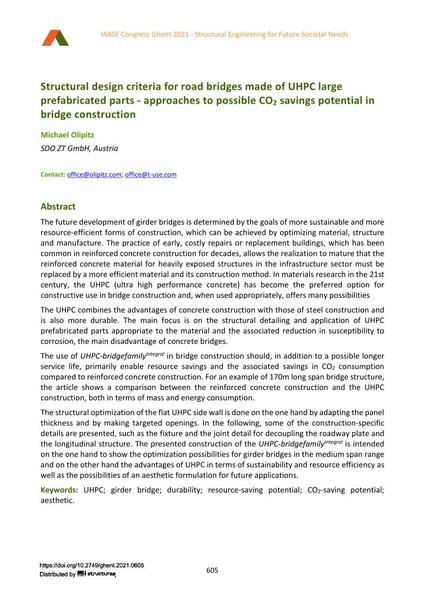Structural design criteria for road bridges made of UHPC large prefabricated parts - approaches to possible CO2 savings potential in bridge construction

|
|
|||||||||||
Bibliographic Details
| Author(s): |
Michael Olipitz
(SDO ZT GmbH, Austria)
|
||||
|---|---|---|---|---|---|
| Medium: | conference paper | ||||
| Language(s): | English | ||||
| Conference: | IABSE Congress: Structural Engineering for Future Societal Needs, Ghent, Belgium, 22-24 September 2021 | ||||
| Published in: | IABSE Congress Ghent 2021 | ||||
|
|||||
| Page(s): | 605-614 | ||||
| Total no. of pages: | 10 | ||||
| DOI: | 10.2749/ghent.2021.0605 | ||||
| Abstract: |
The future development of girder bridges is determined by the goals of more sustainable and more resource-efficient forms of construction, which can be achieved by optimizing material, structure and manufacture. The practice of early, costly repairs or replacement buildings, which has been common in reinforced concrete construction for decades, allows the realization to mature that the reinforced concrete material for heavily exposed structures in the infrastructure sector must be replaced by a more efficient material and its construction method. In materials research in the 21st century, the UHPC (ultra high performance concrete) has become the preferred option for constructive use in bridge construction and, when used appropriately, offers many possibilities The UHPC combines the advantages of concrete construction with those of steel construction and is also more durable. The main focus is on the structural detailing and application of UHPC prefabricated parts appropriate to the material and the associated reduction in susceptibility to corrosion, the main disadvantage of concrete bridges. The use of UHPC-bridgefamilyIntegralin bridge construction should, in addition to a possible longer service life, primarily enable resource savings and the associated savings in CO2 consumption compared to reinforced concrete construction. For an example of 170m long span bridge structure, the article shows a comparison between the reinforced concrete construction and the UHPC construction, both in terms of mass and energy consumption. The structural optimization of the flat UHPC side wall is done on the one hand by adapting the panel thickness and by making targeted openings. In the following, some of the construction-specific details are presented, such as the fixture and the joint detail for decoupling the roadway plate and the longitudinal structure. The presented construction of the UHPC-bridgefamilyIntegral is intended on the one hand to show the optimization possibilities for girder bridges in the medium span range and on the other hand the advantages of UHPC in terms of sustainability and resource efficiency as well as the possibilities of an aesthetic formulation for future applications. |
||||
| Keywords: |
durability girder bridge aesthetic UHPC resource-saving potential CO2-saving potential
|
||||
| Copyright: | © 2021 International Association for Bridge and Structural Engineering (IABSE) | ||||
| License: | This creative work is copyrighted material and may not be used without explicit approval by the author and/or copyright owner. |
||||
